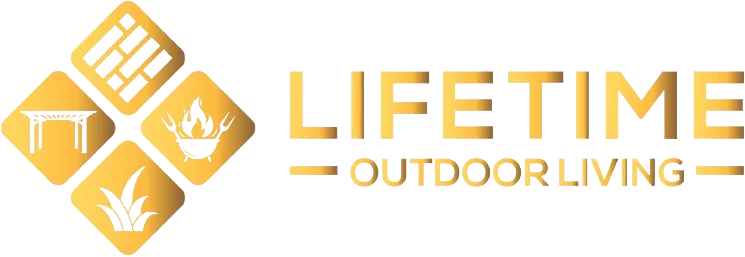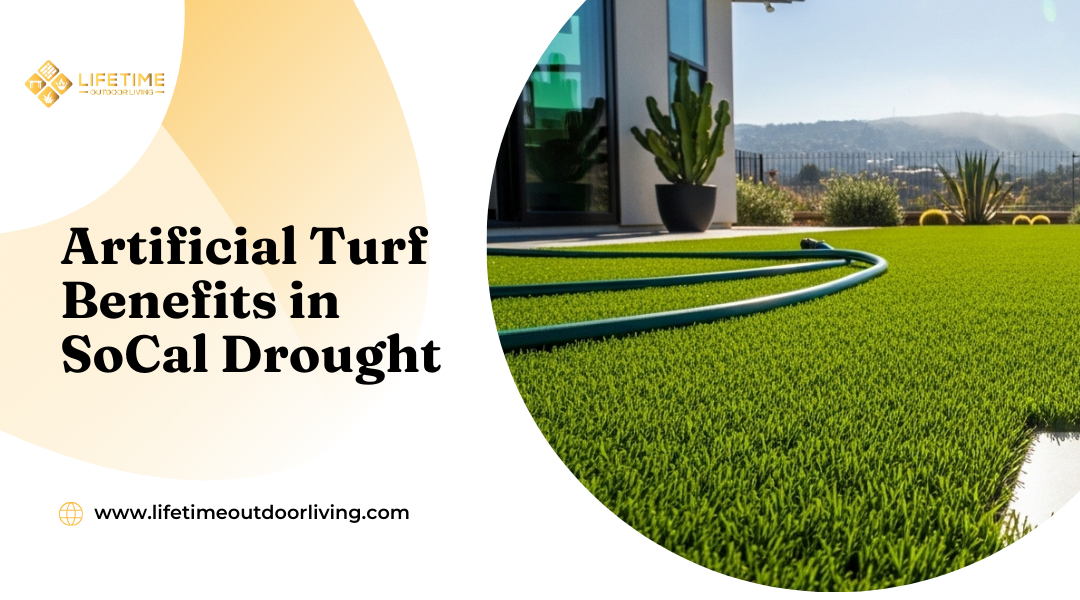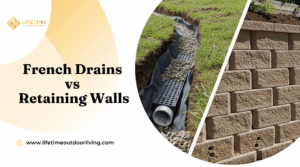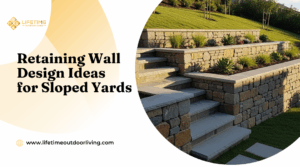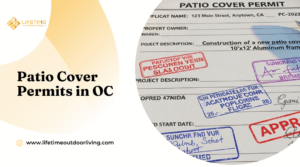Benefits of Artificial Turf During Drought Conditions in SoCal: Save Water & Enhance Your Landscape
Southern California’s ongoing drought makes maintaining a traditional lawn both costly and difficult. Water restrictions, rising utility bills, and dry conditions all contribute to the challenge of keeping grass green year-round. Artificial turf offers a reliable solution by eliminating the need for constant watering while still giving you a vibrant, usable outdoor space.
By choosing synthetic grass, you cut down on water use, reduce maintenance demands, and gain a lawn that looks consistent in every season. Unlike natural grass that browns under stress, turf stays green without irrigation, fertilizers, or pesticides. This makes it a practical option for anyone wanting a low-maintenance yard that aligns with today’s water conservation needs.
At Lifetime Outdoor Living in Laguna Beach, you can take advantage of premium turf installation designed to fit seamlessly with pavers, patios, and other outdoor features. Their expertise ensures your lawn not only saves water but also enhances the overall design of your space, creating a durable and attractive landscape that works with the realities of Southern California’s climate.
The Water Challenge in Southern California
Southern California faces limited water supplies due to recurring droughts and rising demand. Outdoor water use, especially for lawns and landscaping, remains one of the largest contributors to household consumption.
Ongoing Drought and Water Restrictions
Drought conditions in Southern California are not occasional events but recurring challenges. Limited rainfall, hotter summers, and reduced snowpack in the Sierra Nevada all contribute to unstable water supplies.
You face water restrictions that often limit outdoor irrigation to just a few days per week. In some areas, fines apply if you exceed usage limits or water outside permitted hours. These rules aim to conserve resources but also restrict how you maintain your property.
Outdoor water use accounts for 30–60% of household consumption, depending on the season. During peak summer months, sprinklers may need to run several times a week to keep grass alive, which conflicts with conservation requirements.
Water agencies and districts have introduced rebate programs to encourage residents to replace traditional lawns with drought-tolerant alternatives. These programs reflect the growing need to reduce reliance on high-water landscapes.
Impact on Traditional Lawns and Landscapes
A conventional lawn requires significant irrigation to stay green in a dry climate. Without frequent watering, grass quickly turns brown and patchy, especially in hotter inland areas.
You may notice that maintaining a healthy lawn during drought restrictions becomes costly and inefficient. Higher water rates, coupled with limited watering schedules, make it difficult to justify the expense.
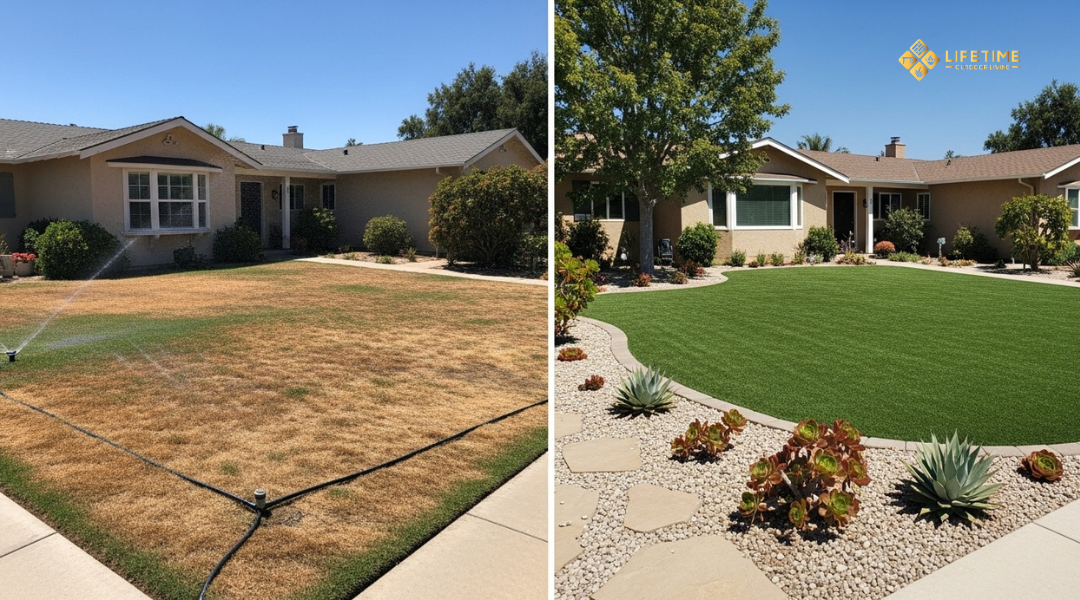
Traditional landscapes also require fertilizers, pesticides, and regular mowing. These inputs add to both financial and environmental costs. In drought conditions, the return on this investment diminishes since water limitations prevent lawns from thriving.
As a result, many homeowners and businesses are rethinking the role of grass in their outdoor spaces. Replacing high-water lawns with water-wise alternatives is becoming a practical response to the region’s ongoing water challenges.
Why Artificial Turf Is a Smart Choice During Drought
Artificial turf reduces outdoor water use, keeps your yard looking maintained in any season, and eliminates the hassle of dealing with dry, patchy grass. It provides a practical way to manage landscaping in areas where drought conditions and water restrictions are common.
Zero Irrigation Needs Save Thousands of Gallons Annually
Natural grass lawns in Southern California can require thousands of gallons of water per year just to stay green. With artificial turf, you remove the need for irrigation entirely. This makes a significant difference in regions where water costs continue to rise and restrictions are frequently enforced.
You still may rinse the surface occasionally to clear dust or pet waste, but this minimal use is a fraction of what sprinklers consume. For many homeowners, this translates into consistent monthly savings on water bills.
Beyond cost, reducing irrigation also supports local conservation efforts. In drought-prone areas, every gallon counts, and choosing turf helps you meet water-saving goals without sacrificing appearance.
Consistent Green Look Regardless of Climate
Artificial turf maintains its color and texture throughout the year, even during extended dry spells. Unlike natural grass that turns brown or patchy under heat stress, turf stays uniform and green.
This reliability means you don’t need to adjust your schedule around watering cycles or seasonal lawn treatments. Your yard remains visually appealing whether it’s midsummer or a cooler winter month.
For homeowners in Laguna Beach, where drought conditions can make traditional lawns difficult to maintain, turf provides a stable, low-maintenance landscape solution. It’s especially useful when local water agencies enforce strict outdoor watering limits.
Eliminating the Risk of Dead Patches and Brown Spots
Dead patches and uneven growth are common problems with natural grass, especially when water is scarce or soil conditions vary. Artificial turf removes this issue by providing a uniform surface that doesn’t depend on irrigation or soil quality.
You won’t need to reseed or replace sections that fail to grow. Turf also prevents the frustration of dealing with pests or lawn diseases that often cause thinning areas.
With no risk of brown spots, your outdoor space remains consistent and usable for gatherings, play areas, or simple curb appeal. This reliability saves you both time and ongoing maintenance costs.
Financial and Environmental Benefits
Artificial turf helps you control costs while also reducing the strain on limited natural resources. By lowering outdoor water use, cutting back on chemical treatments, and easing demand on local water supplies, it provides both financial relief and measurable environmental advantages.
Lower Water Bills and Long-Term Savings
Maintaining a natural lawn in Southern California requires heavy irrigation, especially during dry months. With artificial turf, you eliminate the need for routine watering, which can reduce your household’s outdoor water use by thousands of gallons each year.
This reduction directly lowers your monthly water bills. Over time, the savings add up, often offsetting the initial installation cost. Unlike grass, turf does not require reseeding, sod replacement, or seasonal repairs.
You also avoid expenses tied to sprinkler repairs and irrigation system upkeep. The long lifespan of quality turf—often 15 years or more—means your investment continues to provide cost stability well into the future.
Reduced Fertilizer, Pesticide, and Fuel Use
Artificial turf removes the need for fertilizers and pesticides. This not only saves you money but also keeps harmful chemicals out of local soil and water systems.
You also eliminate the need for gas-powered lawn tools like mowers, trimmers, and blowers. This cuts fuel costs and reduces emissions from small engines, which are a significant source of air pollution in residential areas.
The financial benefit comes from fewer recurring purchases. Instead of spending on bags of fertilizer, weed control products, or gasoline, you keep more of your budget free for other household needs.
Supporting Regional Water Conservation Efforts
Southern California faces recurring drought conditions, and outdoor landscaping is a major source of water demand. By switching to artificial turf, you actively reduce the pressure on local water supplies.
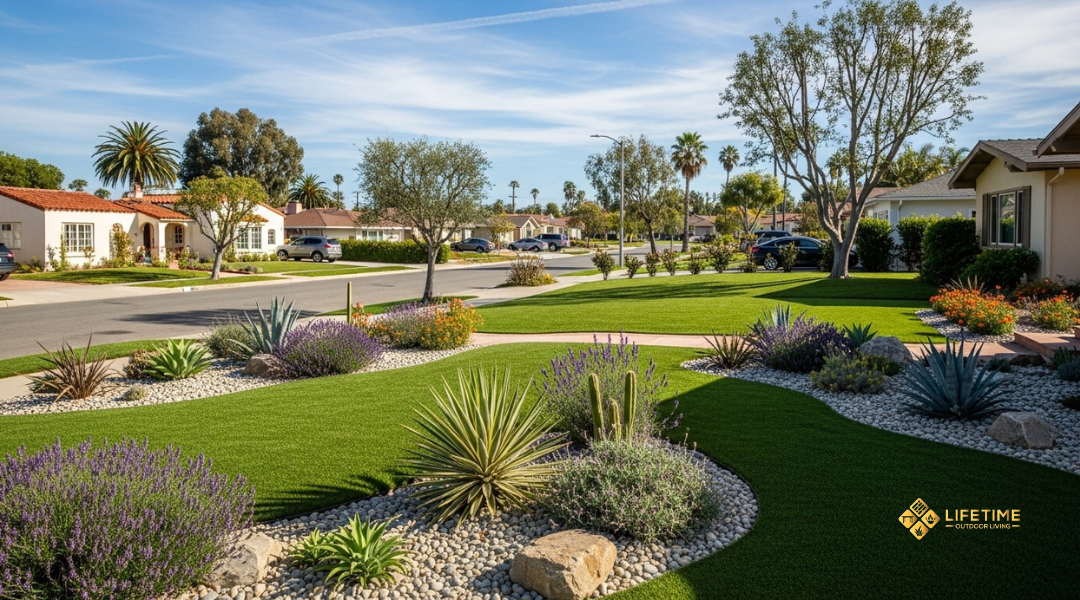
Your property becomes part of a broader conservation effort supported by municipalities and water districts. Many areas even offer rebate programs for turf installation, providing an additional financial incentive.
This shift helps stabilize regional water reserves, ensuring that limited resources are directed toward essential uses. By conserving water at home, you contribute to community-wide resilience during extended dry periods.
Practical Advantages for Homeowners
Artificial turf offers consistent performance in Southern California’s dry climate by reducing water use, limiting upkeep, and staying resilient under regular activity. It also withstands strong sun exposure without fading or breaking down quickly, making it a reliable surface for long-term use.
Minimal Maintenance Compared to Natural Grass
You avoid weekly mowing, edging, and fertilizing when you install artificial turf. Natural grass requires regular irrigation, especially during drought, but turf eliminates that need almost entirely. This shift reduces both your water bill and your time spent on yard work.
Weeds and pests also become less of a concern. With a proper base layer and infill, turf resists weed growth and doesn’t provide a habitat for insects. You may still need occasional brushing or rinsing, but these tasks are infrequent compared to traditional lawn care.
For many homeowners, the most practical advantage is predictability. You know how much upkeep is required, and you can plan around it without unexpected seasonal spikes in maintenance.
Key savings with turf:
- Water: No irrigation required
- Labor: No mowing or fertilizing
- Chemicals: Reduced or eliminated pesticide use
Durable Under Heavy Use from Kids and Pets
Artificial turf is designed to handle frequent foot traffic without developing bare patches or muddy spots. Children can play on the surface daily, and pets can run across it without wearing it thin. Unlike natural grass, it doesn’t turn brown or uneven in high-use areas.
Pet owners benefit from surfaces that drain efficiently. Most turf systems use perforated backing that allows liquids to pass through, reducing odor and making cleanup easier. Solid soil compaction is not an issue, so the lawn remains level and usable.
You also gain consistency across the entire yard. Whether it’s a backyard soccer game or a dog’s daily exercise, the turf keeps its shape and appearance, even after years of use.
UV- and Heat-Resistant Designs for SoCal Sun
Southern California’s sun can damage natural grass and dry it out quickly. Artificial turf uses UV-stabilized fibers that resist fading and breakdown, keeping the surface green for years. This means you don’t need to replace or reseed areas exposed to direct sunlight.
Heat buildup can be a concern, but modern turf products are designed with cooling technology. Some use lighter-colored infill or reflective materials that lower surface temperature compared to older models. This makes the space more comfortable for kids and pets during hot afternoons.
You also benefit from a surface that does not crack or peel under prolonged exposure. Unlike concrete or asphalt, turf remains flexible and consistent, making it a practical choice for year-round outdoor living in Laguna Beach.
Design Flexibility and Aesthetic Value
Artificial turf gives you more control over how your outdoor space looks and functions. It provides a consistent green surface that can be combined with hardscape features, adapted to different design preferences, and used to create practical areas for daily living.
Blending Turf with Pavers, Gravel, and Drought-Tolerant Plants
You can integrate turf with stone pavers, gravel pathways, and native plants to achieve a balanced landscape. This approach reduces water use while maintaining visual interest.
For example, turf strips between pavers soften hard surfaces and create a clean, modern look. Gravel borders can add contrast while improving drainage, which is especially useful in Southern California’s dry climate.
Drought-tolerant plants such as succulents or ornamental grasses pair well with turf. They break up large green areas and introduce texture without requiring heavy irrigation. This mix of elements allows you to design a yard that is both low-maintenance and visually appealing.
Multiple Turf Styles to Match Different Home Aesthetics
Artificial turf is available in different pile heights, blade shapes, and color blends. This variety lets you choose a style that complements your home’s architecture and outdoor features.
If your property has a coastal or modern design, shorter, uniform turf may look best. For more natural settings, longer blades with multi-tone coloring can replicate the look of real grass more effectively.
You can also use turf selectively. For instance, a narrow strip along a walkway can highlight stonework, while a larger section in the backyard provides a lush backdrop for outdoor furniture. Matching the turf style to your home’s character ensures the landscape feels cohesive rather than artificial.
Adding Usable Outdoor Living Space
Turf creates durable, level surfaces that expand your usable outdoor area. Unlike natural grass, it resists wear from heavy foot traffic, making it suitable for play areas, lounge zones, or outdoor dining spaces.
You can combine turf with a paved patio to extend seating areas or use it to frame a fire pit. It also works well under pergolas or shade structures where natural grass often struggles to grow.
This adaptability means you can design functional zones tailored to your lifestyle. Whether you want a low-maintenance play lawn or a clean surface for entertaining, turf helps maximize the value of your outdoor space.
Addressing Common Concerns
When considering artificial turf in Southern California, you may wonder how it handles water during storms, whether it becomes too hot in the sun, and if the materials used are safe for people and pets. These factors directly affect comfort, performance, and long-term satisfaction with your lawn.
Drainage Performance During Rare Heavy Rains
Artificial turf is designed with a perforated backing that allows water to pass through into the base layer. Proper installation includes a compacted foundation of crushed rock or decomposed granite, which promotes drainage and prevents pooling.
In Laguna Beach and other coastal areas, sudden downpours can overwhelm poorly prepared yards. With turf, the key is ensuring the base is graded correctly so water flows away from your home and hardscape features.
A well-installed system can handle several inches of rain per hour without flooding. You avoid muddy patches, soil erosion, and uneven surfaces common with natural grass after storms. By focusing on professional preparation, you gain a surface that remains usable even after rare but intense Southern California rain events.
Heat Buildup and Modern Cooling Technologies
Artificial turf can absorb more heat than natural grass, sometimes reaching 20–30°F higher on hot summer days. This is a valid concern in Southern California where sunlight is strong and frequent.
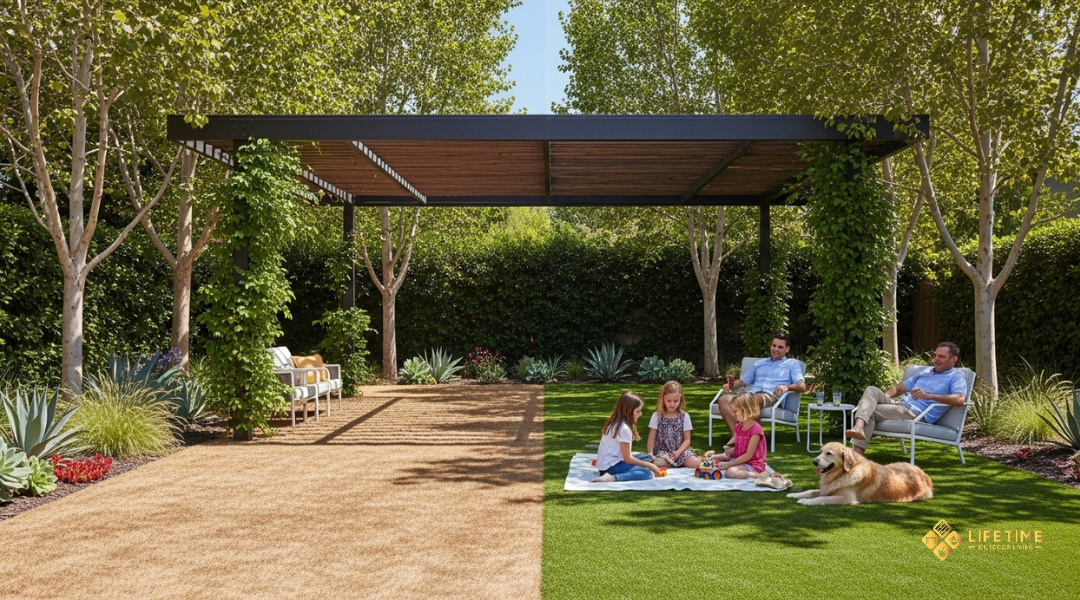
To address this, newer turf products incorporate heat-reflective fibers and cooling infills made from materials like silica sand or coated granules. These reduce surface temperatures and make the turf more comfortable for walking or play.
You can also minimize heat buildup by combining turf with shaded areas, trees, or pergolas. Light-colored infills and turf designs with improved airflow further reduce retained heat. With these options, you can enjoy a green lawn that remains usable even in peak summer conditions.
Safety and Eco-Friendly Materials
Modern turf products use non-toxic, lead-free materials that meet safety standards for residential use. This makes them suitable for children, pets, and everyday outdoor activities.
Infill materials have also advanced. Instead of older rubber crumbs, many systems now use organic infills such as cork or coconut fibers, or recycled alternatives that reduce environmental impact. These options improve cushioning while avoiding harsh chemicals.
You also reduce the need for pesticides, fertilizers, and herbicides that natural lawns often require. This limits chemical runoff into local waterways and supports a safer outdoor environment. By selecting eco-friendly turf options, you create a lawn that balances durability with health and sustainability.
How Lifetime Outdoor Living Helps SoCal Homeowners Transition
You gain the most value from artificial turf when the process starts with careful planning, continues with professional installation, and ends with a cost structure that fits your budget. Each step ensures your new lawn performs well in Southern California’s dry climate while maintaining long-term durability and appearance.
Free Consultation and Custom Design Planning
Your project begins with a free consultation where the team evaluates your property’s layout, sunlight exposure, and soil conditions. This step helps identify whether you need turf designed for high traffic, pet use, or shaded areas.
You receive a tailored design plan that accounts for your lifestyle and outdoor goals. For example, you may want turf that integrates with stone walkways or one that resists wear from frequent gatherings.
During planning, precise measurements are taken to avoid wasted materials and reduce installation costs. You can also review different turf textures and colors to select the option that looks most natural in your yard.
By the end of this stage, you have a clear plan that matches both your functional needs and the visual style of your outdoor space.
Professional Installation with Proper Base and Drainage
A successful turf installation depends on how well the base is prepared. Lifetime Outdoor Living removes existing grass, levels the soil, and installs a compacted layer of crushed rock or decomposed granite. This foundation prevents shifting and ensures proper water drainage.
A weed barrier fabric is placed before the turf to limit growth beneath the surface. The turf is then carefully cut and seamed to fit the unique contours of your yard, including edges along patios, walkways, and garden beds.
Drainage channels are built into the base to prevent pooling during rain. This step is especially important in Southern California, where sudden downpours can damage poorly installed lawns.
The result is a stable, long-lasting surface that stays even under heavy use and avoids common issues like sagging or water buildup.
Financing Options to Make Drought-Smart Upgrades Affordable
You don’t need to delay upgrades due to high upfront costs. Lifetime Outdoor Living offers financing plans that spread payments over time, making it easier to manage the investment.
Flexible payment schedules allow you to choose terms that fit your household budget. This can reduce financial strain while still giving you the immediate benefits of water savings and reduced maintenance.
Some financing programs may also align with local incentives or rebates for drought-resistant landscaping. These can further lower your overall cost and shorten the payback period.
By using financing, you gain access to a sustainable lawn solution without sacrificing affordability or delaying the transition to a water-efficient landscape.
